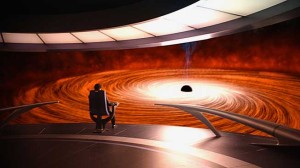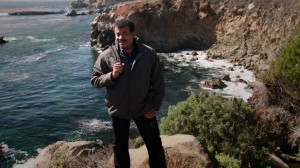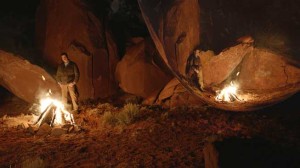
Cosmos: a Spacetime Odyssey, hosted by well-known and telegenic astrophysicist Neil deGrasse Tyson, is widely considered to be one of the most stimulating and visually spectacular shows about science to ever appear on television.
The series is a 21st century version of the landmark series Cosmos: A Personal Journey that was broadcast on the Public Broadcast System in 1980, and was memorably hosted by the late Carl Sagan. The Sagan version is estimated to have been seen by a worldwide audience of over 500 million viewers, making it one of the biggest audiences in the history of public television. Since then there have been huge advances in scientific knowledge, and also in the sophistication of visual effects techniques, so these were incorporated in the latest version.
 The new show premiered in March and recently concluded a 13-episode run on the main Fox channel, and was also shown on the National Geographic cable channel one day later. The ambitious project, which combines live footage, visual effects and animation, was headed by executive producer Brannon Braga who led an all-star team that included director of photography Bill Pope, visual effects supervisor Rainer Gombos, film editor John Duffy and composer Alan Silvestri.
The new show premiered in March and recently concluded a 13-episode run on the main Fox channel, and was also shown on the National Geographic cable channel one day later. The ambitious project, which combines live footage, visual effects and animation, was headed by executive producer Brannon Braga who led an all-star team that included director of photography Bill Pope, visual effects supervisor Rainer Gombos, film editor John Duffy and composer Alan Silvestri.
“We knew we had to make this granddaddy of all science documentaries,” said Braga. “This thing had to look amazing in all of its many moving parts. But above all else and perhaps most importantly, Cosmos had to be an emotional experience.” It was fortunate, he said, “we had one of the original creators of the show,” referring to script writer Ann Druyan, who was married to Sagan and worked with him on the first iteration. “I always knew when I went to work every day, if Ann was happy, the show was working,” said Braga.
 Druyan wrote all 13 episodes for this year’s Cosmos, and her scripts became the backbone of the show. She was also the instigator of the project. “I had a clear picture in my mind of what this new Cosmos had to be, which was commensurately lavish in its special effects and production values as the first Cosmos was for its time,” said Druyan. “It took years to find the right home for it, where I could have complete creative control.” She credited another of the show’s executive producers, Seth McFarlane – the multi-hyphenate actor, writer and director and the creator of numerous animated television shows such as Family Guy – for his full-fledged backing and for getting Fox to air the show, not its typical fare.
Druyan wrote all 13 episodes for this year’s Cosmos, and her scripts became the backbone of the show. She was also the instigator of the project. “I had a clear picture in my mind of what this new Cosmos had to be, which was commensurately lavish in its special effects and production values as the first Cosmos was for its time,” said Druyan. “It took years to find the right home for it, where I could have complete creative control.” She credited another of the show’s executive producers, Seth McFarlane – the multi-hyphenate actor, writer and director and the creator of numerous animated television shows such as Family Guy – for his full-fledged backing and for getting Fox to air the show, not its typical fare.
The series went through a full year of prep, “the longest on any show I’ve ever done,” said Braga. Druyan meanwhile spent the year writing. “When we went into production, we had all 13 scripts completely locked down.” That was necessary because all 13 episodes went into production at the same time, so every element had to be known in advance.
 The scripts contained 275-pages of dialogue for Tyson, who was the shamanic hand-holding guide for viewers, and also determined the many locations around the world where he was filmed speaking his lines. Though he was thoroughly familiar and comfortable with the scientific concepts, he was prepped in advance by speech and acting coaches.
The scripts contained 275-pages of dialogue for Tyson, who was the shamanic hand-holding guide for viewers, and also determined the many locations around the world where he was filmed speaking his lines. Though he was thoroughly familiar and comfortable with the scientific concepts, he was prepped in advance by speech and acting coaches.
“There was a lot of location photography around the visual effects – a lot of sequences were entirely CG – but we tried to use as much live footage as possible to keep costs down,” said VFX supervisor Gombos. “If it is possible, we were told, have Neil do it.”
In order to illustrate both the outer extent of the universe and inner space, the smallest aspects of nature down to unseeable sub-atomic particles, a huge amount of CG was called for. “We had to do things that were at the threshold of science credibility, so they had to be accurate,” said Gombos. A lot of the reference material came from NASA pictures of outer space. More creativity was used to illustrate things on the microscopic, molecular and atomic level.
 Animation was used quite a bit, especially to tell the stories of science pioneers like Galileo and Newton, which was charming and effective. But there was also a budgetary reason behind the decision – it was again cheaper to go with animation than to do the story-telling using CG.
Animation was used quite a bit, especially to tell the stories of science pioneers like Galileo and Newton, which was charming and effective. But there was also a budgetary reason behind the decision – it was again cheaper to go with animation than to do the story-telling using CG.
Bill Pope was both the series DP and he directed a number of the episodes. “The visual effects were by no means afterthoughts, they were woven into the show,” he noted. “But there was a lot of photography involved. In working with the visual effects, we were the dog and they were the tail.”
But Pope had to understand what the visual effects were that were being interwoven to know what to film. “It was a lot of fun trying to do this on the fly but you had to be prepared as well,” he said. “If you had a solid basis in terms of design and the look, then you’re home free; you’re able to play all the jazz you want.”
One imperative was “to make sure that what we were shooting was never boring, always visual. We wanted to make a science-action movie. And ‘visceral’ was one word used over and over.”
 Tyson was filmed in many locations around the world to keep things interesting. But there was also a lot of stock footage employed, most of which came from National Geographic. “There were a lot of aerial shots that were beyond our budget,” said Pope.
Tyson was filmed in many locations around the world to keep things interesting. But there was also a lot of stock footage employed, most of which came from National Geographic. “There were a lot of aerial shots that were beyond our budget,” said Pope.
There was also the problem of going to certain places with Tyson, such as Egypt, Iraq and the Australian outback. So filming for these sequences was done in New Mexico. “We faked it and even built pyramids there,” the DP noted. “I don’t think anyone could tell.”
Pope praised the esprit and camaraderie of those who worked with him on Cosmos. “I was thanked so much by the crew. Everybody was happy to be giving their all,” he said. “They believed in the project, they felt they learned so much, and there was this good feeling all the time.”





